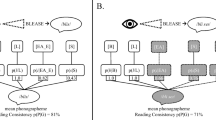Summary
In two experiments the naming task was used to investigate the effect of spelling-to-sound regularity on performance for French words varying in frequency of usage. In both experiments the results showed a significant effect of regularity on naming latencies. Contrary to what has been found in previous experiments using English stimuli, the regularity effect did not vary as a function of word frequency. However, in both experiments significantly more errors, and specifically regularisation errors, were observed with low-frequency irregular words. Several possible interpretations of this atypical pattern of results are discussed. An additional observation was that the regularity effect, both on naming latencies and on error rates, and independently of frequency of use, was limited to the irregular words in which the idiosyncratic orthographic segment was either in initial or in medial position in the word.
Similar content being viewed by others
References
Andrews, S. (1982). Phonological recoding: Is the regularity effect consistent?Memory & Cognition, 10, 565–575.
Backman, J., Bruck, M., Hébert, M., & Seidenberg, M. S. (1984). Acquisiton and use of spelling-sound correspondences in reading.Journal of Experimental Child Psychology, 38, 114–33.
Balota, D. A., Boland, J. E., & Shields, L. W. (1989). Priming in pronunciation: Beyond pattern recognition and onset latency.Journal of Memory and Language, 28, 14–36.
Brown, G. D. A. (1987). Resolving inconsistency: A computational model of word naming.Journal of Memory and Language, 26, 1–23.
Carroll, J., Davies, P., & Richman, B. (1971).The American heritage word frequency book. Boston: Houghton Mifflin.
Catach, N. (1984).La phonétisation automatique du français. Paris: Éditions du Centre National de la Recherche Scientifique.
Coltheart, M. (1978). Lexical access in simple reading tasks. In G.Underwood (Ed.),Strategies of information processing (pp. 151–216). London: Academic Press.
Coltheart, M., Davelaar, E., Jonasson, J. T., & Besner, D. (1977). Access to the internal lexicon. In S.Dornić (Ed.),Attention and performance (Vol. VI, pp. 535–555). London: Academic Press.
Content, A., & Radeau, M. (1988). Données statistiques sur la structure orthographique du français.Cahiers de Psychologie Cognitive, 8, 399–404.
Frost, R., Katz, L., & Bentin, S. (1987). Strategies for visual word recognition and orthographical depth: A multilingual comparison.Journal of Experimental Psychology: Human Perception and Performance, 13, 104–115.
Gak, V. G. (1976).L'orthographe du français. Paris: SELAF.
Hanna, P. R., Hanna, J. S., Hodges, R. E., & Rudorf, E. H. (1966).Phoneme-grapheme correspondences as cues to spelling improvement. Washington, DC: US Government Printing Office.
Henderson, L. (1982).Orthography and word recognition in reading. London: Academic Press.
Katz, L., & Feldman, L. B. (1983). Relation between pronunciation and recognition of printed words in deep and shallow orthographies.Journal of Experimental Psychology: Learning, Memory and Cognition, 9,157–166.
Kay, J., & Marcel, T. (1981). One process, not two, in reading aloud: Lexical analogies do the work of non-lexical rules.Quarterly Journal of Experimental Psychology, 33 A, 397–413.
Imbs, P. (1971).Études statistiques sur le vocabulaire français. Dictionnaire des fréquences. Vocabulaire littéraire des XIXe et XXe siècles. Centre de recherche pour un Trésor de la langue française (CNRS), Nancy. Paris: Librairie Marcel Didier.
Lukatela, G., Popadié, D., Ognjenovié, P., & Turvey, M. T. (1980). Lexical decision in a phonologically shallow orthograpphy.Memory & Cognition, 8, 124–132.
Marcel, T. (1980). Surface dyslexia and beginning reading: A revised hypothesis of the pronunciation of print and its impairments. In M.Coltheart, K.Patterson, & J. C.Marshall (Eds.), Deep dyslexia (pp. 227–258). London: Routledge and Kegan Paul.
Paap, K. R., McDonald, J. E., Schvaneveldt, R. W., & Noel, R. W. (1987). Frequency and pronounceability in visually presented naming and lexical decision tasks. In M.Coltheart (Ed.), Attention and performance: Vol. XII. The Psychology of Reading (pp. 221–243). Hillsdale, NJ: Erlbaum.
Patterson, K. E. (1982). The relation between reading and phonological coding: Further neuropsychological observations. In A. W.Ellis (Ed.), Normality and pathology in cognitive functions (pp. 77–111). London: Academic Press.
Patterson, K. E., & Morton, J. (1985). From orthography to phonology: An attempt at an old interpretation. In K. Patterson, J. C. Marshall, & M. Coltheart (Eds.),Surface dyslexia: Neuropsychological and cognitive studies of phonological reading (pp. 335–359). Hillsdale, NJ: Erlbaum.
Peereman, R. (1989). Représentations phonologiques dans la prononciation et l'identification des mots écrits alphabétiquement. Université Libre de Bruxelles: Unpublished doctoral thesis.
Rosson, M. B. (1985). The interaction of pronunciation rules and lexical representations in reading aloud.Memory & Cognition, 13, 90–99.
Seidenberg, M. (1985). The time course of phonological code activation in two writing systems.Cognition, 19, 1–30.
Seidenberg, M., & McClelland, J. L. (1989). A distributed, developmental model of word recognition and naming.Psychological Review, 96, 523–568.
Seidenberg, M., Waters, G., Barnes, M., & Tanenhaus, M. (1984). When does irregular spelling or pronunciation influence word recognition?Journal of Verbal Learning and Verbal Behavior, 23, 383–404.
Shallice, T., & McCarthy, R. (1985). Phonological reading: From patterns of impairment to possible procedures. In K. E. Patterson, J. C. Marshall, & M. Coltheart (Eds.),Surface dyslexia: Neuropsychological and cognitive studies of phonological reading (pp. 361–397). Hillsdale, NJ: Erlbaum.
Taraban, R., & McClelland, J. L. (1987). Conspiracy effects in word pronunciation.Journal of Memory and Language, 26, 608–631.
Véronis, J. (1988). From sound to spelling in French: Simulation on a computer.European Bulletin of Cognitive Psychology, 8, 315–334.
Waters, G., & Seidenberg, M. (1985). Spelling-sound effects in reading: Time-course and decision criteria.Memory & Cognition, 13, 557–572.
Waters, G., Seidenberg, M., & Bruck, M. (1984). Children's and adults' use of spelling-sound information in three reading tasks.Memory & Cognition, 12, 293–305.
Wijk, A. (1966).Rules of pronunciation for the English language. Oxford: Oxford University Press.
Author information
Authors and Affiliations
Rights and permissions
About this article
Cite this article
Content, A. The effect of spelling-to-sound regularity on naming in French. Psychol. Res 53, 3–12 (1991). https://doi.org/10.1007/BF00867327
Issue Date:
DOI: https://doi.org/10.1007/BF00867327




